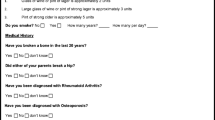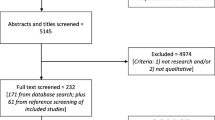Abstract
The FRAX® tool that calculates the 10-year probability of having a fracture has recently been validated for Belgium. Little is known about the perception and knowledge that GPs have about this tool in their daily practice. A survey has been conducted as part of a screening campaign for various diseases. The primary objective of the present study was to assess the perception and the knowledge of the FRAX® tool by GPs. The secondary objective was to assess the impact of an information brochure about the FRAX® tool on these outcomes. The survey was sent to a sample of 700 GPs after only half of them had received the information brochure. The survey results show that, out of the 193 doctors who responded to the survey, one-third know the FRAX® tool but less than 20 % use it in their daily clinical practice. Among those who use it, the FRAX® tool is largely seen as a complementary but not as an essential tool in the diagnosis or in the management of osteoporosis. It appears that the brochure could improve the knowledge of the FRAX® tool but it would not be more efficient on its use in daily practice than the other sources of information. At present, the use of the FRAX® tool in Belgium is limited but an information brochure could have a positive impact on the knowledge of the FRAX® tool.




Similar content being viewed by others
References
Raisz LG (2005) Clinical practice. Screening for osteoporosis. New Engl J Med 353:164–171
Werner P (2005) Knowledge about osteoporosis: assessment, correlates and outcomes. Osteoporosis Int 16:115–127
Taylor JC, Sterkel B, Utley M, Shipley M, Newman S, Horton M, Fitz-Clarence H (2001) Opinions and experiences in general practice on osteoporosis prevention, diagnosis and management. Osteoporo Int 12:844–848
Morris CA, Cabral D, Cheng H, Katz JN, Finkelstein JS, Avorn J, Solomon DH (2004) Patterns of bone mineral density testing: current guidelines, testing rates, and interventions. J Gen Intern Med 19:783–790
Kanis JA, Burlet N, Cooper C, Delmas PD, Reginster JY, Borgstrom F, Rizzoli R (2008) European guidance for the diagnosis and management of osteoporosis in postmenopausal women. Osteoporos Int 19:399–428
Kanis JA, McCloskey EV, Johansson H, Oden A, Strom O, Borgstrom F (2010) Development and use of FRAX in osteoporosis. Osteoporos Int 21(Suppl 2):S407–S413
Johansson H, Kanis JA, McCloskey EV, Oden A, Devogelaer JP, Kaufman JM, Neuprez A, Hiligsmann M, Bruyere O, Reginster JY (2011) A FRAX(R) model for the assessment of fracture probability in Belgium. Osteoporos Int 22:453–461
Neuprez A, Johansson H, Kanis JA, McCloskey EV, Oden A, Bruyere O, Hiligsmann M, Devogelaer JP, Kaufman JM, Reginster JY (2009) A FRAX model for the assessment of fracture probability in Belgium. Rev Med Liege 64:612–619
Levy BT, Hartz A, Woodworth G, Xu Y, Sinift S (2009) Interventions to improving osteoporosis screening: an Iowa Research Network (IRENE) study. JABFM 22:360–367
Tellier V, De Maeseneer J, De Prins L, Sedrine WB, Gosset C, Reginster JY (2001) Intensive and prolonged health promotion strategy may increase awareness of osteoporosis among postmenopausal women. Osteoporos Int 12:131–135
Johansson H, Kanis JA, McCloskey EV, Oden A, Devogelaer JP, Kaufman JM, Neuprez A, Hiligsmann M, Bruyere O, Reginster JY (2011) A FRAX(R) model for the assessment of fracture probability in Belgium. Osteoporos Int 22:453–461
Weiss TW, Siris ES, Barrett-Connor E, Miller PD, McHorney CA (2007) Osteoporosis practice patterns in 2006 among primary care physicians participating in the NORA study. Osteoporos Int 18:1473–1480
Chenot R, Scheidt-Nave C, Gabler S, Kochen MM, Himmel W (2007) German primary care doctors’ awareness of osteoporosis and knowledge of national guidelines. Exp Clin Endocrinol Diabetes 115:584–589
Kastner M, Straus SE (2008) Clinical decision support tools for osteoporosis disease management: a systematic review of randomized controlled trials. J Gen Intern Med 23:2095–2105
Dejesus RS, Angstman KB, Kesman R, Stroebel RJ, Bernard ME, Scheitel SM, Hunt VL, Rahman AS, Chaudhry R (2012) Use of a clinical decision support system to increase osteoporosis screening. J Eval Clin Pract 18:89–92
Dejesus RS, Chaudhry R, Angstman KB, Cha SS, Tulledge-Scheitel SM, Kesman RL, Bernard ME, Stroebel RJ (2011) Predictors of osteoporosis screening completion rates in a primary care practice. Popul Health Manag 14:243–247
Simonelli C, Killeen K, Mehle S, Swanson L (2002) Barriers to osteoporosis identification and treatment among primary care physicians and orthopedic surgeons. Mayo Clinic Proc 77:334–338
Perez-Edo L, Ciria Recasens M, Castelo-Branco C, Orozco Lopez P, Gimeno Marques A, Perez C, Manasanch Dalmau J (2004) Management of osteoporosis in general practice: a cross-sectional survey of primary care practitioners in Spain. Osteoporos Int 15:252–257
Jaglal SB, McIsaac WJ, Hawker G, Carroll J, Jaakkimainen L, Cadarette SM, Cameron C, Davis D (2003) Information needs in the management of osteoporosis in family practice: an illustration of the failure of the current guideline implementation process. Osteoporos Int 14:672–676
Solomon CG, Connelly MT, Collins K, Okamura K, Seely EW (2000) Provider characteristics: impact on bone density utilization at a health maintenance organization. Menopause 7:391–394
Lafata JE, Kolk D, Peterson EL, McCarthy BD, Weiss TW, Chen YT, Muma BK (2007) Improving osteoporosis screening: results from a randomized cluster trial. J Gen Intern Med 22:346–351
Acknowledgments
The authors would like to thank the Province of Liege for their unrestricted educational support.
Conflict of interest
The authors declare that they have no conflict of interest.
Author information
Authors and Affiliations
Corresponding author
Rights and permissions
About this article
Cite this article
Bruyère, O., Nicolet, D., Compère, S. et al. Perception, knowledge, and use by general practitioners of Belgium of a new WHO tool (FRAX®) to assess the 10-year probability of fracture. Rheumatol Int 33, 979–983 (2013). https://doi.org/10.1007/s00296-012-2461-x
Received:
Accepted:
Published:
Issue Date:
DOI: https://doi.org/10.1007/s00296-012-2461-x




